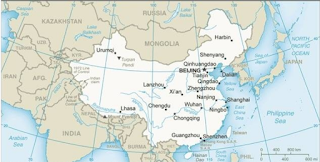
#17,218
Nearly 3 years after China closed their borders and enacted their `Zero-COVID' policy - and little more than a month after reversing that policy - the Mainland dropped their mandatory 10-day quarantine and COVID testing for new arrivals starting today.
This move comes two weeks after China stopped reporting on their escalating COVID epidemic, and exactly 2 weeks before the Chinese (aka `Lunar') New Year, which falls on January 22nd this year.
According to China, their epidemic is `predictable and under control', although other, non-sanctioned reports paint a completely different picture. While difficult (or impossible) to fully verify, we've seen numerous leaked reports of swamped hospitals and crematoriums running 24/7.
Among some of the frantic reports on social media, the term `White Lung' is showing up often; which describes the presentation of severe pneumonia on an X-ray.
Early in the pandemic between 5%-10% of cases involved pneumonia - aka `COVID lung' - but since the arrival of Omicron, pneumonia has become a far less common complication.
Sharon Sanders on FluTrackers overnight picked up a Chinese language report on an interview with an NHC official Jiao Yahui (see below), who is quoted as saying the incidence of pneumonia among COVID cases in China is `about 8%'.
Jiao Yahui is the deputy head of Medical Policy and Administration Bureau under National Health Commission (NHC).
Jiao Yahui: about 8% of people with pneumonia after Yang in my country
January 08, 2023 09:11 CCTV Author: Popular Science China
190
About 8% of the people with pneumonia after positive in my country
[#中国阳后出现病病量量应该8%#]#国际白病征流微标南#
After Implementing Class B and B Controls#Jiao Yahui, director of the Department of Medical Affairs of the National Health and Health Commission: "In each version of the diagnosis and treatment plan, there is a mild case. Symptoms such as fever, cough, and sore throat, but the mild type does not have pneumonia.
The common type is pneumonia. According to the classification of clinical cases of Amicron in our country in 2022, pneumonia appears, that is to say The proportion of common type is quite low, that is, less than 10%, about 8%.
Now because of the large base of infection, the absolute value of pneumonia must be large. Because no matter how low the ratio is, our country has a large population base, so if it is converted into an absolute value, it is not a small number.”
Assuming this assessment to be accurate, then China is seeing far higher rates of COVID-related pneumonia than the rest of the world is right now. Given the presumed (but unreported) high number of daily infections (in the millions), it would explain why hospitals are so overloaded in China.
While some worry that this suggests a more virulent variant is circulating in China, this could also be the result of a far more immunologically naive population in China.
- China's vaccines were rolled out early, and while hundreds of millions of people recieved them - they were the older inactivated virus vaccines, not the mRNA vaccines mostly used in the West - and reportedly have provided less protection against the newer Omicron variants.
- And as a result of their Zero-COVID policy, most of China's population avoided infection with the earlier COVID variants, and have no acquired immunity.
With Hong Kong opening up travel with the Mainland today - if (and it is still an `if') - there is a new, unknown variant circulating in China, we should learn about it fairly quickly.
January 8, 2023
The Secretary for Security, Tang Bingqiang, said that the resumption of customs clearance between Hong Kong and the Mainland went smoothly. By 10 am, more than 7,000 people had left Hong Kong and headed north. He believes that there were not many parallel importers in the initial stage of customs clearance, and the authorities have a lot of experience in cracking down on related problems, and will send personnel to hot spots of parallel imports to take action when necessary.
Although it goes by many names - Chunyun in China, Seollal in Korea, and Tết Nguyên Đán in Vietnam - the lunar new year is the most important holiday in all of Asia. Before the pandemic, it sparked the largest yearly migration of humans in the world as hundreds of millions of people traveled home-and-back for the Holidays.
The Spring travel season typically begins about 15 days before the Lunar New Year and runs for about 40 days total, during which time more than 2 billion passenger journeys will be made (mostly via crowded rail and bus) across Asia.
These mass migrations (along with mass gatherings like the Hajj, Carnival and the Super Bowl) are of considerable interest to public health officials and epidemiologists, even when we aren't in the midst of a pandemic (see The Impact Of Mass Gatherings & Travel On Flu Epidemics).
While COVID is the obvious concern right now, there are plenty of other viral threats that these migrations can launch onto a world tour, including seasonal flu variants, avian and swine flu strains, and MERS-CoV.
Which is why, particularly over the next six weeks, public health agencies around the globe will be on heightened alert for any new disease threats.